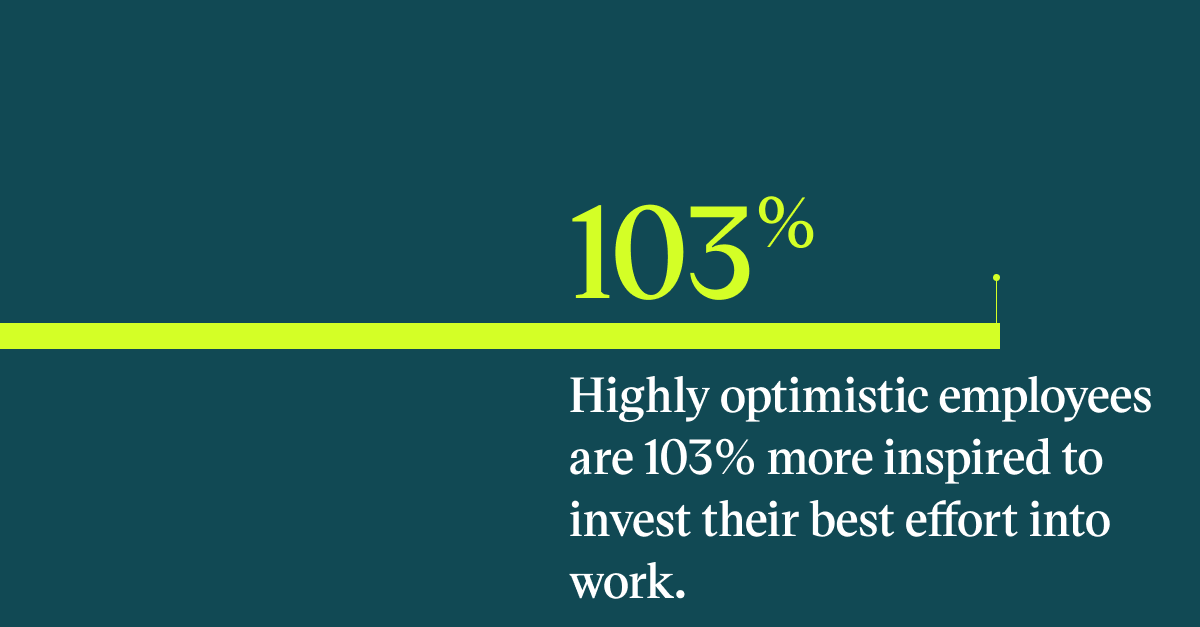
The case for optimism: a conduit to innovation, agility and effective change

Optimism. A word that might sit uncomfortably with many of us, considering the tumultuous global climate we find ourselves in.
Optimism can be commonly perceived as blind passivity, sitting immoveable by present pressures and urgent actions, and choosing to naively pay attention only to the good.
Though in reality, the active and adaptable view of the optimist is highly responsive to its surroundings and possibilities. Optimism benefits not only the individual, but can also unlock increased innovation and success in their workplace.
Bringing in expert insight from Project Optimism's Noirin Mosley and Jenny Boymal, let's explore the active, agile and decisive sides to optimism.
Active optimism

Optimism requires action. It is not tunnel-visioned naivety - and could possibly be better described as the opposite to tunnel-visioned pessimism.
Optimists believe in positive possibilities, though contingent on their active participation driving the outcome. They will actively work towards more innovative and positive outcomes for themselves and those around them, even when driven by negative scenarios.
Research from the BetterUP coaching program found that employees who balance optimistic action with thoughtful pragmatism and reflection tended to be more successful, hopeful and less stressed.
Highly optimistic employees are also 103% more inspired to invest their best effort into work.
Unlocking optimism
As Jenny notes here, the real power of optimism is when it is unlocked in others. Particularly for leaders, empowering others to establish and build upon their own optimistic behaviors has a compounding effect.
Our brain's ability to learn and adapt, with the goal of bettering ourselves or our circumstances, is driven by optimism. This function, neuroplasticity, is our neural network seeking and establishing new connections to adapt and evolve to better current scenarios as well as future predictions.
The ‘Habits of an optimist’ course from Project Optimism, within the Go1 Content Library, is an insightful resource for discovering optimistic habits and behavior hacks. Did you know that habits can account for 40% of our behaviors. Learned optimism, boosted by optimistic habits, is possible.
Optimism in a crisis
As Noirin mentions, The Great Resignation is an impressive example of optimistic behaviours within a crisis. Within large scale disruption, individuals choosing change for a better present or future.
Optimism also drives agile capabilities when teams are found at organizational road blocks. In 2020, fashion rental company Rent the Runway found their revenue plummeting (their business model relied heavily upon occasion wear). CEO Jennifer Hyman used the pause to double down on system and structural improvements that had been de-prioritized during their high-growth years. She noted that it became a 'time for creation and creativity.'
Some of the strongest drivers of resilience is found in optimistic behaviors. The ability to stay emotionally balanced during difficult situations, reflective and agile are all powerfully supported by optimism.
Optimism is not contingent upon ignoring negative factors and situations, but clinging to the belief that things can change, and we hold the power to contribute to that change.

Akaash Maharaj, CEO of the Global Organization of Parliamentarians Against Corruption, beautifully summed up optimism when he said;
“Optimism is a creed for the brave. Pessimists' and cynics' certainty that nothing can be done gives them a ready excuse to do nothing and to risk nothing. By contrast, the optimist knows that better is always possible, and so he is compelled to make the effort work towards happier ends, even at the risk of disappointment.”
Rather than being relegated to toxic-positivity, optimism is a crucial conduit to risk-taking, innovation, change and ultimately, building a better future. It can be found in the brave innovator, the agile risk-taker and the compassionate leader. And most importantly, optimism can be learnt.
Humans at Work

This auditing and planning tool will guide you in finding the right learning for your team, so they can turn up to work authentically themselves and thrive.
If you are a current Go1 customer, you can complete the guide in partnership with your CSM, and they will add a Humans at Work learning plan into your current learning structure.
If you are not currently a customer and are interested in elevating your workplace's mental health and wellbeing learning, we would love to help.
Download the Humans at Work guide now to start moving towards psychologically safer workplaces.




